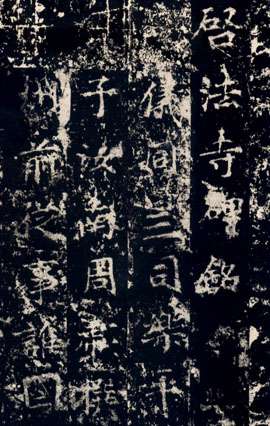Dingdao was born in Huqiao County (now Bo County, Anhui Province). The year of birth and death is unknown. A calligrapher during the reign of Emperor Wen of the Sui Dynasty. The official is engaged in offering wine in Xiangzhou. He was good at authentic calligraphy and was very famous at that time. He had a great influence on authentic calligraphy in the early Tang Dynasty. Ming Fengfang's "Shu Jue" lists four people from the Sui Dynasty who were good calligraphers since Zhong and Wang, and Ding Daohu's name was the third. Mi Fu's "Haiyue Quotes" regards Ding Daohu as being similar to Ouyang Xun and Yu Shinan of the Tang Dynasty, and as those who reformed the ancient law. Huang Bosi of the Northern Song Dynasty said in "Dongguan Yulun" that "Tao protects neither the past nor the present, and is charming and lawful." There is an engraved version of "Qifa Xingguo Temple Stele", and there is a cut and mounted rubbing copy handed down from generation to generation. It is the only rubbing copy handed down to the world and has been exported to Japan. .

Qifa Temple was rebuilt on April 1, the fourth year of Emperor Kaihuang's reign (584), by Wei Shikang, the governor of Qizhou. It was first named "Guangfu Temple" and later changed to "Qifa Temple", which was the "Longxing Temple" of the Song Dynasty. In the Sui Dynasty, the ministers of the Sui Dynasty, Fu Si brothers, and their father Wei Shikang established the temple affairs. On December 15, the second year of Renshou (602), the stele was erected. Zhou Biao wrote the text, Ding Daohu Shudan, Li Bao inscribed, and Zhao Li Others named. The calligraphy on this stele is in regular script, neat and elegant, and the brushwork is skillful. It is Ding Daohu's masterpiece.
Caixiang of the Song Dynasty commented on "Qifa Temple Stele": "This book is also a legacy of the later Wei Dynasty. ... Between the Sui and Tang Dynasties, there were many people who were good at calligraphy, and they all came up with the same method. Daohu gained the most." Ruan Yuan's "Bei Stele and South Tie Lun" It is thought that Ding Daohu and Fang Yanqian came out of the Northern School together, and there is a comment that "Fang Yanqiu's strength is not like that of Shinan". This is the main calligraphy of the stele. The calligraphy is straight and beautiful. It is the same legal heir as Zhiyong and should come from the "two kings". Therefore, Cai Xiang is known as "Ding Zhenyongcao".
The original stone of this stele has been lost, and only the Song rubbings from the Song Dynasty were handed down from the collection of Li Zonghan of Linchuan, bearing the seal of "Wei Guogong Seal" by Jia Sidao. The description first appeared in Ouyang Xiu's "Collection of Ancient Records and Postscript". The Qifa Temple stele was erected in Xiangyang, Hubei Province in the second year of Renshou, Emperor Wen of the Sui Dynasty. It is one of the few steles in the Sui Dynasty signed by the author. The stele of Ding Daohu is a very mature regular script, with a straight frame and strict rules. It is actually the forerunner of Tang regular script. Even if it is placed among Tang regular script, it is not inferior at all. The calligraphy skills of Tang Dynasty calligraphers can be vaguely seen.








